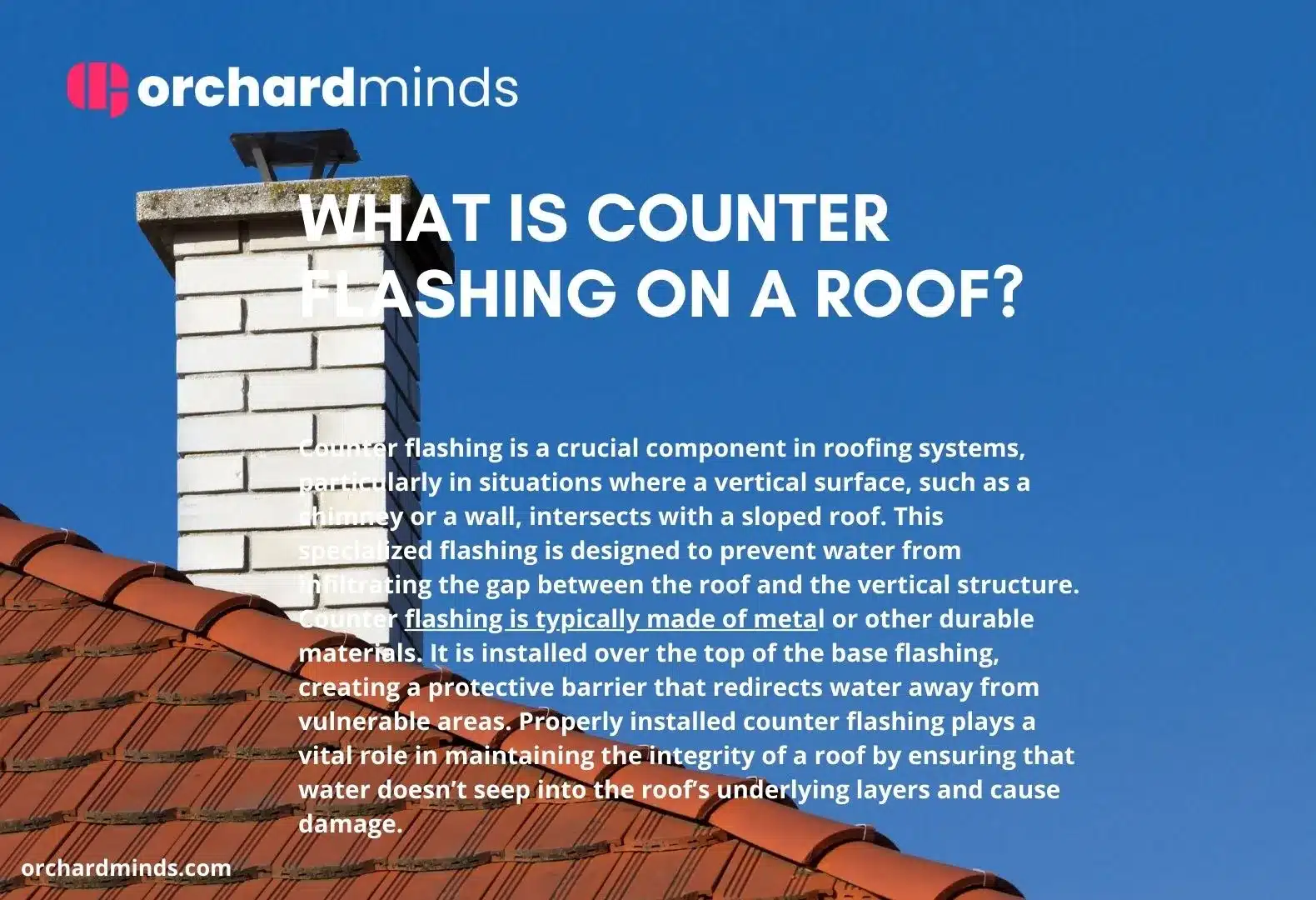What is counter flashing on a roof?
This applies in roofing systems where a vertical structure such as a chimney or wall intercepts a sloping roof, and the counter flashing plays an essential role here. It is a specially designed type of flashing to prevent water from getting into the gap between the roof and the vertical structure.
The counter flashing is generally made of metal or any other robust material. It is installed over the top of the base flashing, creating a protective barrier that redirects the water away from vulnerable areas. Properly installed counter flashing is pretty essential to maintaining the integrity of a roof.
Why You Need to Know About Counter Flashing
Understanding counter flashing is an integral part of roofing and property maintenance because it is among the most important things to do in preventing water damage and maintaining structural integrity. Poor counter flashing, or counter flashing that has been improperly set, can spell a plethora of ultimate problems, from leaks and rot to other very costly issues. Knowing about counter flashing allows one to make sure they have been correctly installed besides ensuring that water has been diverted on the roof from vulnerable areas associated with the roof and vertical surfaces’ intersection points like chimneys or walls. Since this keeps your roofing system watertight and long-lasting, it protects your investment in your property and sidesteps future structural problems.
What is Counter Flashing
Counter flashing is a roofing element that provides more comprehensive protection from water intrusion at the juncture of a roof and any vertical structure, such as a chimney, wall, or, at times, a parapet. It is commonly made of metal or other sturdy materials to be installed over the uppermost edge/bottom, otherwise known as the base flashing. It acts as a protective barrier that diverts rainwater and moisture away from vulnerable areas so that the roof’s integrity is maintained to prevent water damage within the building. Proper installation of counter flashing is quite essential in having a roofing system that will last long and function properly, thereby making this feature quite essential in construction and also property maintenance.
Problems with Counter Flashing
Counter flashing, when not correctly installed or maintained, can lead to several issues. One common problem is water infiltration, which can cause leaks and structural damage over time. If the counter flashing comes loose or deteriorates, it may not effectively divert water away from vulnerable areas, making the roof and building susceptible to moisture damage. Additionally, poor workmanship or the use of incompatible materials can lead to aesthetic issues and reduce the overall durability of the roofing system. Regular inspection and maintenance are essential to address and prevent these problems and ensure that counter flashing performs its crucial role in protecting a building from water-related damage.
Common Materials Used for Counter Flashing
Aluminum
Aluminum is a popular material for counter flashing due to its lightweight and corrosion-resistant properties. It is easy to work with and offers a cost-effective solution for protecting roof intersections. While not as durable as some other materials like copper, it can still provide excellent protection when properly installed and maintained. Its malleability makes it suitable for various roof profiles and is often used in regions where harsh weather conditions are not a significant concern.
Copper
Copper is a premium choice for counter flashing due to its exceptional durability and resistance to corrosion. Over time, copper develops a beautiful patina that adds an aesthetic appeal to buildings. It is often preferred for historical or high-end architectural projects, and its long lifespan can make it a cost-effective option in the long run. Copper counter flashing is known for its ability to withstand harsh weather conditions and is an excellent choice for long-lasting protection.
Galvanized Steel
Galvanized steel counter flashing is a sturdy and economical option for roof intersections. The steel is coated with a layer of zinc, which provides protection against corrosion, making it suitable for a wide range of climates. While it may not have the same aesthetic appeal as copper, it offers strong and reliable performance when correctly installed. It is a practical choice for projects where budget considerations are important, and long-term durability is still a priority.
Installing Counter Flashing After Building a Chimney
Installing counter flashing after constructing a chimney is a popular approach to water protect the chimney-to-roof transition adequately. A cut or reglet is typically made into the masonry or surface of the chimney to receive the counter flashing.
The counterflashing is then installed, and its top edge is embedded in the chimney’s mortar joints. Correct installation is crucial as incorrect installation can enable water to seep into the wall behind the flashing. In that regard, retrofitting can be viewed as one very reasonable measure toward eliminating potential water infiltration at chimneys and preserving the roofing system.
Improperly Installed Flashing Is a Common Cause of Roof Leaks
Improper flashing installation is indeed one of the most common reasons for leaking. Flashing actually serves as a pertinent barrier that provides obstruction to water entry into sensitive areas of the roof, like chimneys, vents, skylights, and roof intersections. When flashing is not installed correctly, it may, over time be subject to gaps, cracks, or separations, due to which it allows the penetration of water and infiltration into the under-layers of the roof. As a result of this, your home may experience moisture damage due to leakage, rot, mold growth, and ceiling staining. Flashing installation and service are done to ensure a watertight roofing system; this therefore means that a faulty flashing installation or service will be a key concern since it will bring about a costly or even an expansive roof repair.
Maintenance on the Roof and Chimney
The most crucial aspect in terms of durability and actual performance of the roof and the chimney is maintenance. Maintenance on the roof itself will include missing or damaged shingles, leaks or cracks in flashing, and debris inside the gutters and downspouts that need to be cleaned for proper drainage. Maintenance also includes inspection of cracks in the masonry, the integrity of a cap, and the condition of the flashing and mortar joints. Concerning cleaning, it is essential for maintenance to have the chimney flue cleaned because the creosote buildup can result in a fire hazard. Therefore, proactive maintenance helps you find the exact problems and thus fix them before anything runs out of hand; it lengthens the roof and chimney’s shelf life and aids in evading costly repairs in the future.
When to Call a Professional
You should call a professional for roof and chimney issues when you have problems that are beyond what you can safely or effectively handle yourself that require specialized contractors’ tools and, of course, knowledge, like significant roof leaks, extensive chimney damage, and stuff affecting the structure. It is no less important, though, to turn to professionals for regular checking and maintenance, unless, of course, you know what to do and how to do that without endangering yourself. Let a qualified roofing or chimney professional enter the scene so the problems will be assessed and treated properly, and thus a long-lasting roof and chimney, and a safe one, will be a matter of fact.



Leave a Comment